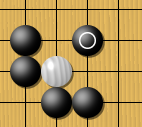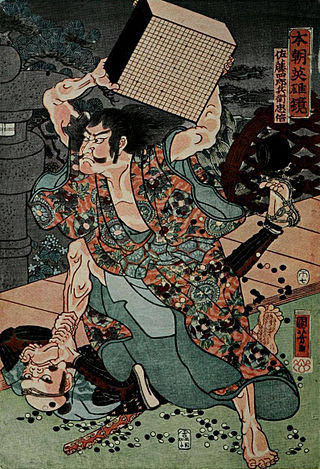This list of books about Go is for books about the board game Go.
This list of books about Go is for books about the board game Go.

Go is an abstract strategy board game for two players in which the aim is to surround more territory than the opponent. The game was invented in China more than 2,500 years ago and is believed to be the oldest board game continuously played to the present day. A 2016 survey by the International Go Federation's 75 member nations found that there are over 46 million people worldwide who know how to play Go and over 20 million current players, the majority of whom live in East Asia.

The game of Go originated in China in ancient times. It was considered one of the four essential arts of a cultured Chinese scholar in antiquity and is described as a worthy pastime for a gentleman in the Analects of Confucius. It reached Korea by the 5th century, in the 7th century it had reached Japan. The game was described by Thomas Hyde in 1694, but it did not become popular in the West until the late 19th century.

In go and shōgi, a jōseki or jouseki is the studied sequences of moves for which the result is considered balanced for both black and white sides.
The nadare jōseki is one of the most celebrated jōseki in the opening stage game of Go, and the one that has been most deeply studied in modern times. Hundreds of unique variations have appeared in high-level games. Aside from the taisha joseki, which has traditionally been said to have more than 1000 known variations, the avalanche is thought to be the most complex joseki; but the nadare fits much better with current ideas on opening strategy and is often used, while the taisha has been quite unfashionable for a generation as the 5-3 corner opening has gone out of favor.
Richard Bozulich is an American author, publisher of Go books in English and college math professor. He co-founded the Ishi Press. He has worked with several Japanese professional players. He has a regular go column in The Daily Yomiuri, Japan's largest English-language newspaper. He lives in Chigasaki, Japan. In 2012 Bozulich was a candidate for Comptroller of New York City for the War Veterans Party.

Cho Chikun25th HoninboHonorary Meijin is a professional Go player and a nephew of Cho Namchul. Born in Busan, South Korea, he is affiliated to Nihon Ki-in. His total title tally of 75 titles is the most in the history of the Japanese Nihon Ki-in. Cho is the first player to hold the top three titles—Kisei, Meijin, and Honinbo—simultaneously which he did for three years in a row. Cho is the first in history to win all of the "Top 7" titles in Japan which he achieved by winning the Oza in 1994. Cho U in 2011 and Iyama Yuta in 2013 would duplicate this feat, both by winning the Kisei. He is also one of the 'Six Supers' Japanese players that were most celebrated in the late twentieth century, along with Rin Kaiho, Otake Hideo, Takemiya Masaki, Kato Masao and his classmate and arch-rival Kobayashi Koichi. He is the author of several books on Go.

Rin Kaihō or Lin Haifeng is a professional Taiwanese Go player who made his name in Japan. He is, along with Cho Chikun, Kobayashi Koichi, Otake Hideo, Takemiya Masaki and Kato Masao, considered one of the 'Six Supers' that dominated Japanese Go world in the last three decades of the twentieth century.

Eio Sakata was a 9-dan Japanese professional Go player.

Hosai Fujisawa was a professional Go player. Hideyuki Fujisawa is his uncle.

Masaki Takemiya is a professional Go player.
Jūbango (十番碁) is a Japanese term for a Go match consisting of ten games which might be ended earlier if agreed by both players. A decisive victory would result in the opponent being 'beaten down' to a lower rank. A player would be beaten down if he fell behind his opponent by four wins in the net score. This would mean a change in the playing terms corresponding to a handicap suitable for a rank difference of one rank. Some notable historical jūbango players are Go Seigen (1914-2014), Kitani Minoru (1909–75), Honinbo Shuei (1852-1907) and Hashimoto Utaro (1907-94).
Satoshi Yuki is a Japanese professional Go player.
The Shusaku opening, or Shusaku fuseki (秀策流布石), is a famous traditional fuseki for black stones in the game of Go. It was developed to perfection by Honinbo Shusaku and passed down to the Meiji, Taishō, and Shōwa eras.

A Go opening refers to the initial moves of a game of Go. On the traditional 19×19 board the opening phase of the game usually lasts between 15 and 40 plies. There is some specialised terminology for go openings. The precise meanings of Japanese language terms is often misunderstood.
Yasuro Kikuchi was a Japanese amateur Go player.

In the game of Go, shape describes the positional qualities of a group of stones. Descriptions of shapes in go revolve around how well a group creates or removes life and territory. Good shape can refer to the efficient use of stones in outlining territory, the strength of a group in a prospective fight, or making eye shapes so that a group may live. Bad shapes are inefficient in outlining territory and are heavy. Heavy groups cannot easily make eye shapes and are therefore good targets for attack. Understanding and recognizing the difference between good shape and bad is an essential step in becoming a stronger player.
In the game of Go, a ladder,(征子) is a basic sequence of moves in which an attacker pursues a group in atari in a zig-zag pattern across the board. If there are no intervening stones, the group will hit the edge of the board and be captured.
Fortress is both a Static Rook opening and a castle in shogi.

Igo Hatsuyōron is a collection of 183 go problems, compiled in 1713 by the Japanese go master Inoue Dōsetsu Inseki.